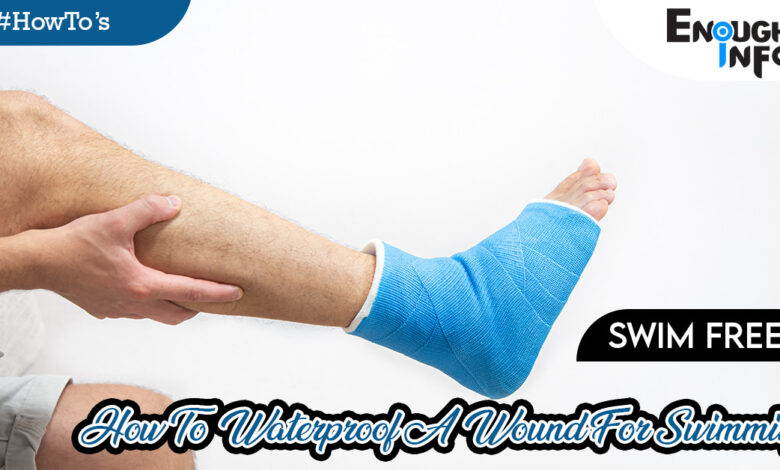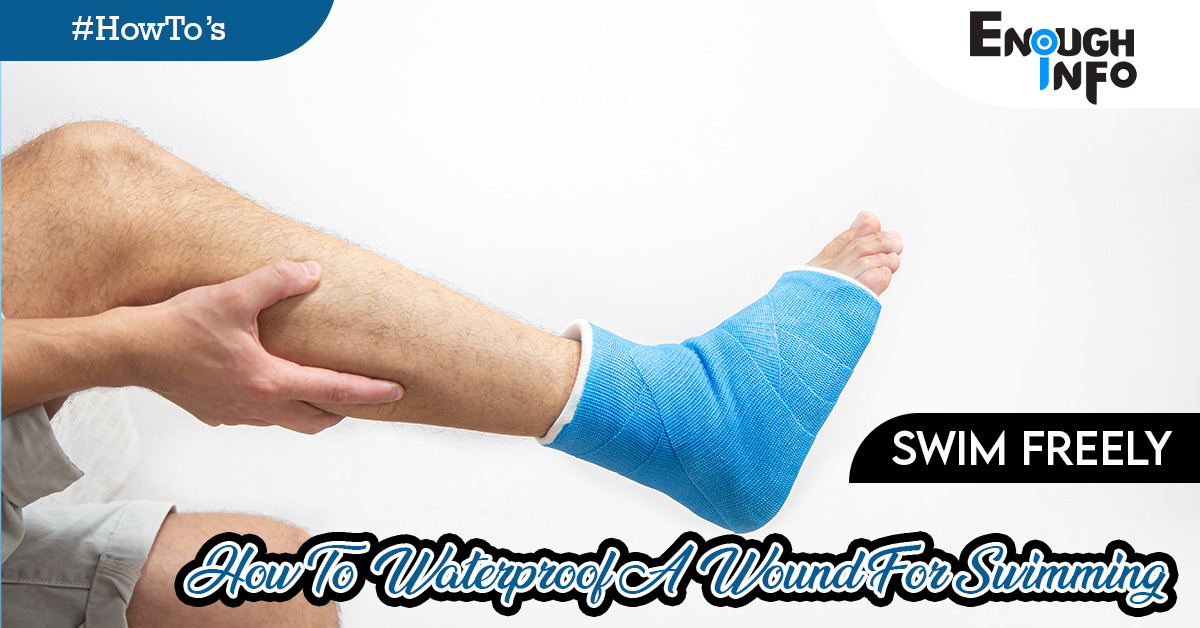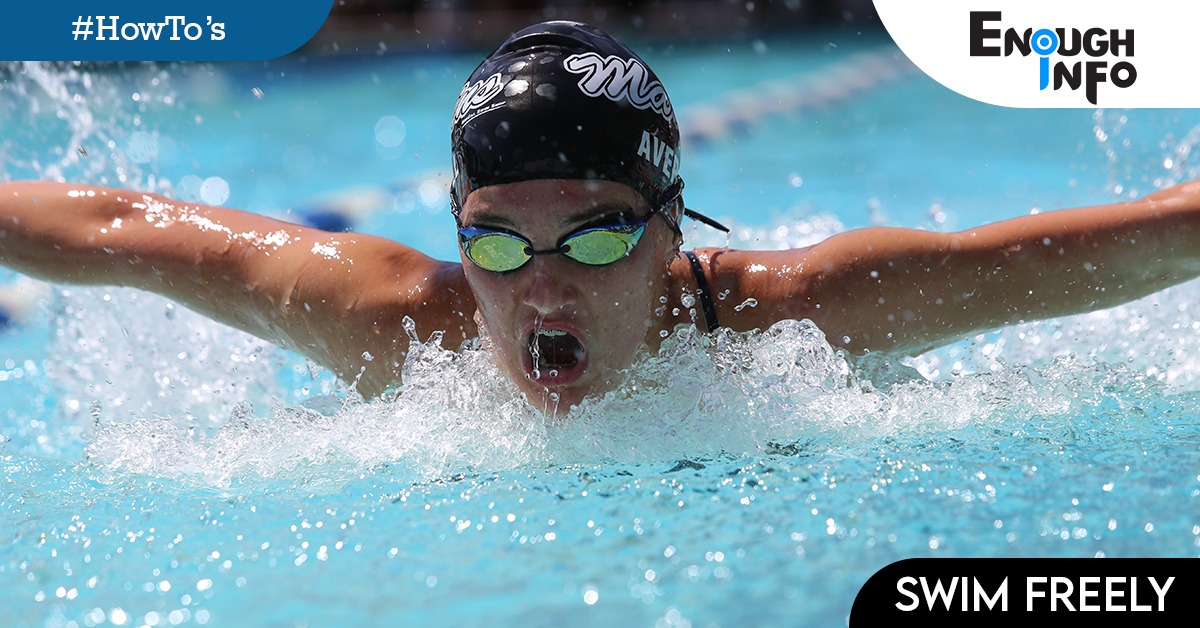
How To Waterproof A Wound For Swimming: Many people take part in swimming as a kind of recreation. However, it can be difficult to find methods to enjoy the water while keeping a wound that needs care dry and shielded from the water. Keeping a wound from becoming infected while swimming is essential for a speedy recovery. There are a number of tried-and-true techniques and supplies that can help you keep your wound intact while you swim. EnoughInfo.com

In this manual, we’ll go over some of the best practices for keeping your wound dry when swimming. Before swimming in a pool or saltwater, read this blog article to learn how to properly protect your wounds.
Read Also: How To Be A Better Sports Player
Why Should Wounds Be Covered When Swimming?
Even with open wounds, swimming is a popular pastime. Water entering the wound through your bandage might result in infections or other problems, despite the fact that it can be enjoyable and relaxing. Putting a wound that is just starting to heal up in the pool is never a good idea since it will not only clear out any filth but also introduce dangerous germs into the body that might cause an infection.
Additionally, if someone has a play injury, such as scratches on their knees from falling off their bike while pedaling around town, it is advisable to keep them out of the water until they have had time to heal. They should not be exposed to water until they have! How To Get Fiberglass Out Of Clothes(Ultimate Guide)
FAQs & Answers on How to waterproof a wound for swimming
1. Can someone with an open wound swim in a pool?
While still open, wounds shouldn’t be submerged in water for at least 48 hours [2]. Active wounds increase the risk of infection, such as tetanus or Hepatitis B and C, while swimming in a pool. Before swimming, it’s crucial to carefully clean any incisions to get rid of any germs that may have been left behind by previous swimmers.
2. Can bandages that are waterproof keep wounds dry when swimming?
Bandages that are waterproof are made particularly to reject water and keep their adhesion even when immersed. They can be useful for keeping wounds dry when swimming, but it’s crucial to get the right size and apply them according to the manufacturer’s guidelines.
Read Also: How To Train For A 5K Race(The Ultimate Guide)
3. Can I waterproof a wound using normal tape?
Regular tape is not intended to be waterproof and might not be able to provide a strong enough water barrier. It is advised to use sealants or tapes that are waterproof and intended for this use.
4. How long can I swim while my wound is waterproofed?
Depending on the kind of wound, technique of waterproofing, and individual circumstances, the suggested time limitations for swimming with a waterproofed wound may change. It’s critical to go by any instructions or suggestions given to you by your healthcare provider in order to avoid issues.
When swimming, it’s crucial to protect open wounds because
- By doing this, germs won’t be able to enter the body via water;
- This may assist in preventing infections or other problems from emerging if a wound becomes soiled and damp; How To Write An Effective Cover Letter
- People who have open wounds should avoid entering any bodies of water, particularly public pools where there is a higher chance of contamination and infection;
- Keeping wounds away from water aids in their quicker healing and prevents them from being worse than they were initially;

Covering Your Wound
Waterproof bandages or tape are the most essential item you’ll need if you want to learn how to waterproof a wound for swimming. Your outermost layer of protection against water leaking into the wound on your skin and irritating it will be this.
These are better than petroleum jelly because they don’t go gummy when submerged in water for a long time, whereas petroleum jelly does when it is diluted by the chemicals in the pool and is also less effective at preventing infection-causing bacteria from entering an open wound while submerged in chlorinated pools.
Read Also: How To Treat A Burn At Home (All you need to Know)
Here’s how to treat your wound:
Use tape or a waterproof bandage to cover the skin wound
It’s important to avoid covering this part of your body in too many clothes in order to prevent ventilation. For it to heal effectively, there should be some air circulation. This will enable extra fluid, such as pus (i.e., white blood cells), that has accumulated in the open lesion to drain out without being trapped beneath any covering material, which might spread infection. How To Get Paint Off Vinyl Floors(The Ultimate Guide)
Make sure your outermost layer of clothing is wicking and not cotton
Since water will be in close touch with the wound, you should make sure that your outermost layer of clothing is wicking and not cotton. While a material like nylon or polyester would allow for greater transmission of sweat away from the skin to keep it dry, cotton retains moisture (the latter being preferred).
Don’t get any chlorinated pool water on an open wound on your body
If you receive chlorinated pool water on an open wound while swimming, wash it off with tap water before drying it. Despite the lack of evidence, some doctors believe that adding alcohol to a fresh wound might damage nerves or tissue because alcohol slows blood flow, which may slow new cell growth surrounding the incision.
About Waterproof Plasters
Swimming pools are harmful for the healing of wounds. It’s crucial to take precautions against any open wounds before swimming since the chlorine in the water might harm your skin.
Plasters that are waterproof act as bandages, preventing contact with pool water. When entering the bathtub or swimming pool, you may use them over cuts, grazes, and wounds to keep them dry. Plasters manufactured expressly to prevent open wounds from being exposed to chemicals present in swimming pools or chlorinated water are known as waterproof plasters. Always make sure you have a proper product before entering any form of chlorinated environment. Regular adhesive dressings won’t protect your wound if exposed to these chemicals.
Waterproof plasters are made by several different companies; Elastoplast is one such company. Your purchase should include instructions on how to use them effectively. Using a waterproof plaster will keep you from coming into touch with chlorinated water, allowing you to swim in a pool without worrying about becoming hurt or infected. These plasters are often flexible and unaffected by moisture.

Uses Of Water-proof Plaster
- Before applying a plaster, clean the wound to prevent the introduction of any further impurities. After washing, pat the surface dry with a paper towel or cotton wool; How To Dispose of Muriatic Acid(All You Need To Know)
- Avoid rubbing the region dry as this may irritate it;
- Before placing your plaster, spread a uniform coating of antibacterial cream over the whole area (not just the border);
- If you don’t, there’s a chance that bacteria may spread to wider regions and infect more than one area of your body at once. Therefore, leave around half an inch between this and healthy skin surrounding the wounds. This needs time to soak in, so don’t use a waterproof plaster until it has completely dried;
- Make sure your injury is entirely dry before putting plaster since this is the most crucial step;
Read Also: 11 Benefits of Organic Skincare for Sensitive Skin
Check the Water Condition if You Have a Wound
You are aware that there are several kinds of wounds. Accidental or intentional wounding may result in pain and the possibility of infection. However, if you have a cut on your skin and are swimming in open bodies of water, such as lakes, seas, or rivers, this might be problematic, particularly if the wound is exposed to soiled and polluted water that may raise the risk of illnesses like tetanus.
Here, professionals provide some advice on how to waterproof a wound while swimming if you wish to go swimming despite having a wound: FUTMINNA 2023 Post-UTME/DE Form: Minimum Score and Requirements
- Make careful to apply antibiotic ointment to your damaged region at least an hour before entering fresh water (lakes, rivers, etc.);
- To ensure that no water seeps in and reaches your wound, it is crucial to wrap or tape over the injured region. For at least 24 hours, you should leave the cover taped on, but as soon as you notice any swelling, you should remove it; How To Tell If A Libra Man Is Playing You
- Swimmers who want to swim in open bodies of water (lakes, rivers) should think about wearing protective gear, such as wetsuits, to assist lower their chance of suffering injuries while swimming. Because these clothing items protect not only while dressing up but also serve as an additional layer of defense against diseases after diving into freshwater, particularly during colder months when individuals are more likely to cut themselves owing to dry skin; How To Have A Successful Relationship With A Mama’s Boy
Conclusion
To protect the wound from water-based toxins and encourage normal healing, it is crucial to waterproof a wound before swimming. You may enjoy swimming while lowering the risk of infection and making sure the wound stays dry by evaluating the wound, cleaning and dressing it correctly, and using waterproof bandages, tapes, or protective covers. When participating in aquatic activities while nursing a wound, keep in mind to always put your safety and well-being first and to abide by any instructions or suggestions made by your healthcare provider.
Recommended;
How To Be A Clean Person (10 Great Ways)
Outdoor Fitness Exercises Safe for Seniors (Best 15)
How to Become a Lifeguard (The Ultimate Guide 2023)




